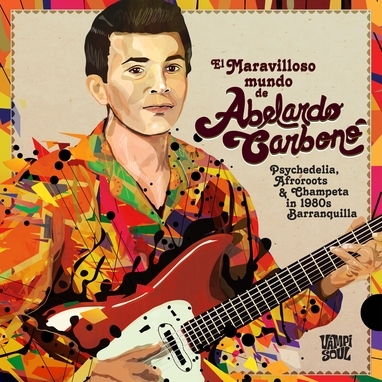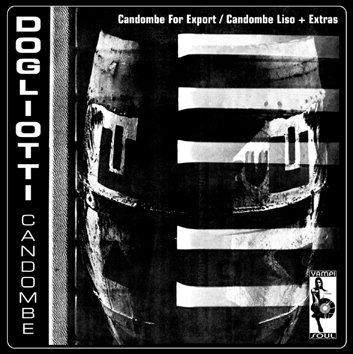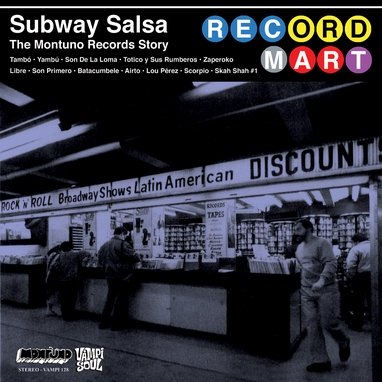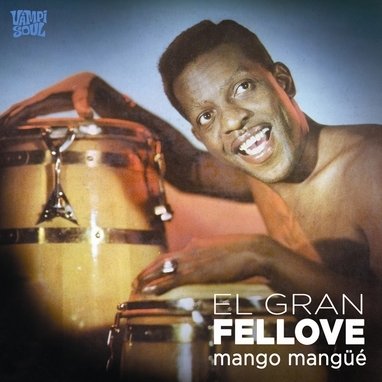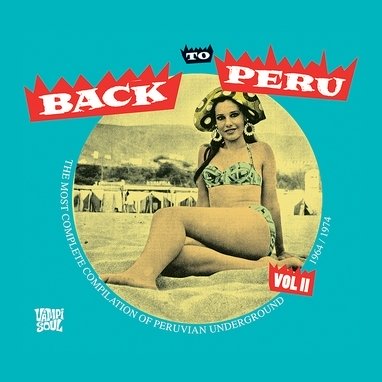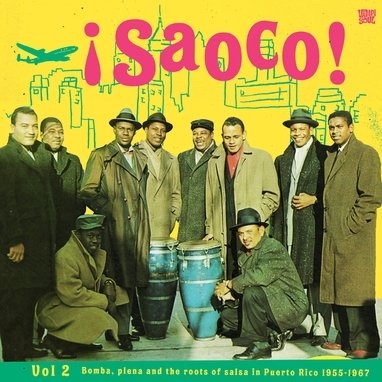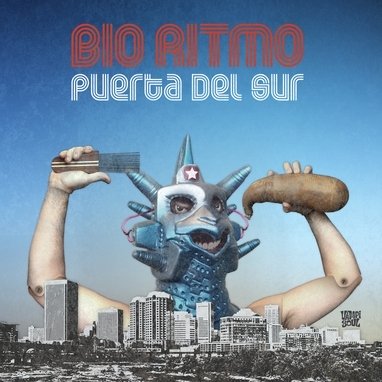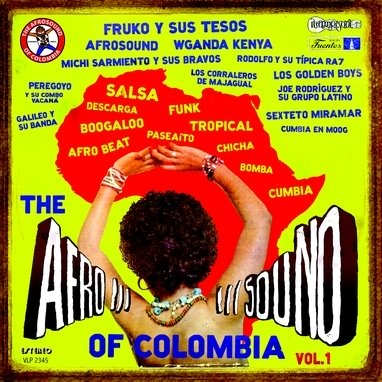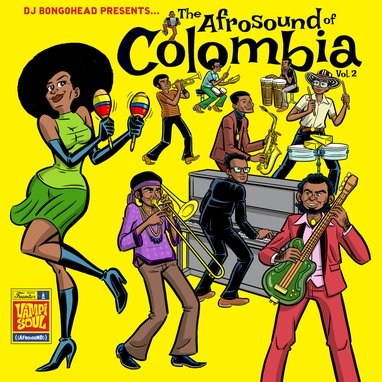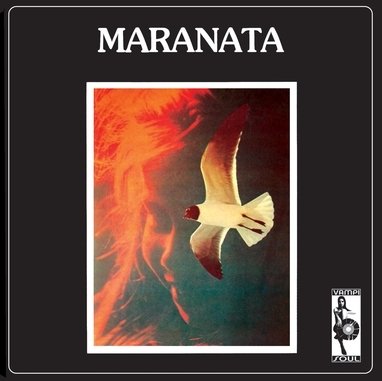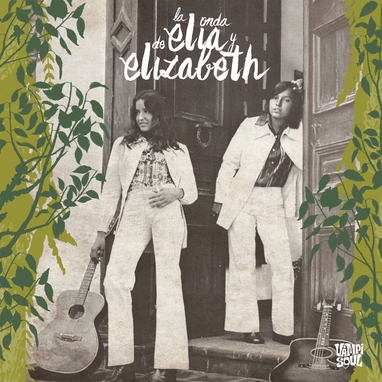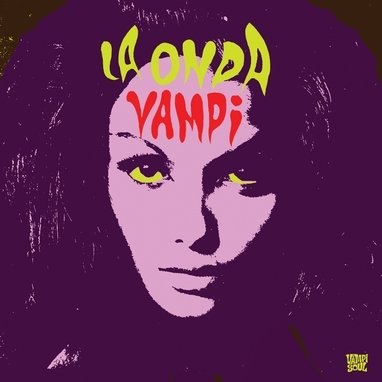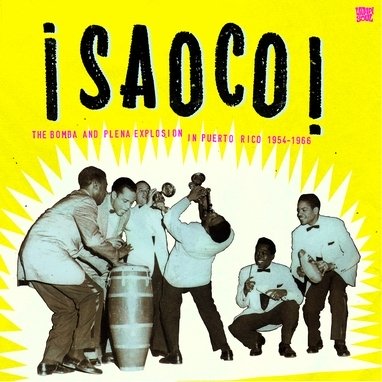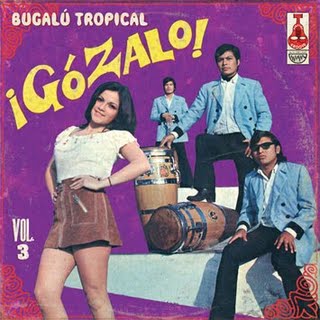Abelardo Carbonó
El maravilloso mundo de…
Vampisoul
Abelardo Carbonó
El maravilloso mundo de…
Abelardo Carbonó, the godfather of champeta, is a legendary Colombian musician who reached a pioneering creative peak in the 1980s with his recordings in the city of Barranquilla. His music knows no boundaries and draws from Afrobeat, highlife, cumbia, Haitian compas, psychedelia… This compilation presents the ground-breaking and kaleidoscopical work of this unclassifiable artist: the wonderful world of Abelardo Carbonó and his Afro-Colombian psuchedelic sound. Compiled by Lucas Silva of Palenque Records and annotated by Etienne Sevet
Abelardo Carbonó, the godfather of champeta, was born in 1948 in Ciénaga, a small town between Santa Marta and Cartagena, Colombia. He started playing guitar when he was eight or nine, just playing along with his father. His family moved to Barranquilla in 1959. Upon his arrival, he quickly went to become a police cadet as it was pretty much all the city had to offer him in terms of earning one’s life. At the turn of the 80s, Abelardo had almost two decades of being in the police, a job he “wasn’t very good at”. With his brothers Jafeth (bass) and Abel (solo guitar), he progressively formed what was to become the nucleus of the bands to come, developing their signature: a sharp guitar, a strong bass and a choir that only brothers’ voices can deliver. The tropical pop sound, the groaning voice, the drum kit, the mix of rockish and tropical guitar that one would hear later in Abelardo’s work, were already visible in his personal way of playing Caribbean music in these early days. Although tracks like ‘A otro perro con ese hueso’ may not be exactly developing the same kind of sound, there was already a resemblance in terms of format and arrangement. The vallenato cajón drum, a traditional feature one would rarely consider beyond vallenato circles, was used here and would be used extensively by Abelardo in various contexts. With its childish voices drowned in reverb, the swinging electric bass contrasting with the acoustic guitar, and the funny lyrics about a man who promises a lot as the choir rejects his affirmations, the tune stood out of a 12-song compilation released by Sonolux and gained Abelardo’s band attention from the music industry. Other tracks like ‘Quiero a mi gente’ and ‘Schallcarri’ seem to testify once again that Fela Kuti’s “Shakara” had a huge impact on the musicians from the coast; the West African and French Caribbean influence became more and more obvious in the band’s work, despite Abelardo claiming that he wasn’t listening to radio, nor looking for records. In fact, the most decisive influence was the African and Afro Caribbean one: it ranged from the Super Negro Bantous to South African music, the 45s from Kenya and of course Congolese music, Cameroon , Ivory Coast, Haitian music, French West Indies… Funk and pop were also important, just as vallenato, cumbia and porro to name a few. For several years, Abelardo enjoyed the savoir faire and experience of the best studios around and worked with producers such as the great Eduardo Dávila, some sort of costeño Lee Perry, out of which came out memorable sessions with collaborations by legends like Michi Sarmiento and several artists from the Dolcey Gutiérrez Orchestra. The groove was the law, and what a groove! In his albums for Felito, Abelardo recorded such gems as ‘Negra Kulenge’, ‘Palenque’ or ‘Carolina’, magnified by a great sound and a unique mix. But, for some reason he cannot explain, the follow up to those albums was not, as one could expect, immediate. He recalls having trouble to handle the destiny of his band and actively promote it to find gigs. Instead he even went to the Guajira region as a policeman or to work for the coal mine, supposedly to teach music in the mining company’s schools there. The best of this boundless artist is yet to come. Europe and the rest of the world is finally about to discover the talent of this kind of Colombian Tom Zé. A man representing the psychedelic yet groovy side of the Caribbean musical world, one of the best kept secrets of Colombian music.
Productos relacionados
Abelardo Carbonó, the godfather of champeta, is a legendary Colombian musician who reached a pioneering creative peak in the 1980s with his recordings in the city of Barranquilla. His music knows no boundaries and draws from Afrobeat, highlife, cumbia, Haitian compas, psychedelia… This compilation presents the ground-breaking and kaleidoscopical work of this unclassifiable artist: the wonderful world of Abelardo Carbonó and his Afro-Colombian psuchedelic sound. Compiled by Lucas Silva of Palenque Records and annotated by Etienne Sevet
Abelardo Carbonó, the godfather of champeta, was born in 1948 in Ciénaga, a small town between Santa Marta and Cartagena, Colombia. He started playing guitar when he was eight or nine, just playing along with his father. His family moved to Barranquilla in 1959. Upon his arrival, he quickly went to become a police cadet as it was pretty much all the city had to offer him in terms of earning one’s life. At the turn of the 80s, Abelardo had almost two decades of being in the police, a job he “wasn’t very good at”. With his brothers Jafeth (bass) and Abel (solo guitar), he progressively formed what was to become the nucleus of the bands to come, developing their signature: a sharp guitar, a strong bass and a choir that only brothers’ voices can deliver. The tropical pop sound, the groaning voice, the drum kit, the mix of rockish and tropical guitar that one would hear later in Abelardo’s work, were already visible in his personal way of playing Caribbean music in these early days. Although tracks like ‘A otro perro con ese hueso’ may not be exactly developing the same kind of sound, there was already a resemblance in terms of format and arrangement. The vallenato cajón drum, a traditional feature one would rarely consider beyond vallenato circles, was used here and would be used extensively by Abelardo in various contexts. With its childish voices drowned in reverb, the swinging electric bass contrasting with the acoustic guitar, and the funny lyrics about a man who promises a lot as the choir rejects his affirmations, the tune stood out of a 12-song compilation released by Sonolux and gained Abelardo’s band attention from the music industry. Other tracks like ‘Quiero a mi gente’ and ‘Schallcarri’ seem to testify once again that Fela Kuti’s “Shakara” had a huge impact on the musicians from the coast; the West African and French Caribbean influence became more and more obvious in the band’s work, despite Abelardo claiming that he wasn’t listening to radio, nor looking for records. In fact, the most decisive influence was the African and Afro Caribbean one: it ranged from the Super Negro Bantous to South African music, the 45s from Kenya and of course Congolese music, Cameroon , Ivory Coast, Haitian music, French West Indies… Funk and pop were also important, just as vallenato, cumbia and porro to name a few. For several years, Abelardo enjoyed the savoir faire and experience of the best studios around and worked with producers such as the great Eduardo Dávila, some sort of costeño Lee Perry, out of which came out memorable sessions with collaborations by legends like Michi Sarmiento and several artists from the Dolcey Gutiérrez Orchestra. The groove was the law, and what a groove! In his albums for Felito, Abelardo recorded such gems as ‘Negra Kulenge’, ‘Palenque’ or ‘Carolina’, magnified by a great sound and a unique mix. But, for some reason he cannot explain, the follow up to those albums was not, as one could expect, immediate. He recalls having trouble to handle the destiny of his band and actively promote it to find gigs. Instead he even went to the Guajira region as a policeman or to work for the coal mine, supposedly to teach music in the mining company’s schools there. The best of this boundless artist is yet to come. Europe and the rest of the world is finally about to discover the talent of this kind of Colombian Tom Zé. A man representing the psychedelic yet groovy side of the Caribbean musical world, one of the best kept secrets of Colombian music.
Productos relacionados
El maravilloso mundo de…
Abelardo Carbonó, the godfather of champeta, is a legendary Colombian musician who reached a pioneering creative peak in the 1980s with his recordings in the city of Barranquilla. His music knows no boundaries and draws from Afrobeat, highlife, cumbia, Haitian compas, psychedelia… This compilation presents the ground-breaking and kaleidoscopical work of this unclassifiable artist: the wonderful world of Abelardo Carbonó and his Afro-Colombian psuchedelic sound. Compiled by Lucas Silva of Palenque Records and annotated by Etienne Sevet
Abelardo Carbonó, the godfather of champeta, was born in 1948 in Ciénaga, a small town between Santa Marta and Cartagena, Colombia. He started playing guitar when he was eight or nine, just playing along with his father. His family moved to Barranquilla in 1959. Upon his arrival, he quickly went to become a police cadet as it was pretty much all the city had to offer him in terms of earning one’s life. At the turn of the 80s, Abelardo had almost two decades of being in the police, a job he “wasn’t very good at”. With his brothers Jafeth (bass) and Abel (solo guitar), he progressively formed what was to become the nucleus of the bands to come, developing their signature: a sharp guitar, a strong bass and a choir that only brothers’ voices can deliver. The tropical pop sound, the groaning voice, the drum kit, the mix of rockish and tropical guitar that one would hear later in Abelardo’s work, were already visible in his personal way of playing Caribbean music in these early days. Although tracks like ‘A otro perro con ese hueso’ may not be exactly developing the same kind of sound, there was already a resemblance in terms of format and arrangement. The vallenato cajón drum, a traditional feature one would rarely consider beyond vallenato circles, was used here and would be used extensively by Abelardo in various contexts. With its childish voices drowned in reverb, the swinging electric bass contrasting with the acoustic guitar, and the funny lyrics about a man who promises a lot as the choir rejects his affirmations, the tune stood out of a 12-song compilation released by Sonolux and gained Abelardo’s band attention from the music industry. Other tracks like ‘Quiero a mi gente’ and ‘Schallcarri’ seem to testify once again that Fela Kuti’s “Shakara” had a huge impact on the musicians from the coast; the West African and French Caribbean influence became more and more obvious in the band’s work, despite Abelardo claiming that he wasn’t listening to radio, nor looking for records. In fact, the most decisive influence was the African and Afro Caribbean one: it ranged from the Super Negro Bantous to South African music, the 45s from Kenya and of course Congolese music, Cameroon , Ivory Coast, Haitian music, French West Indies… Funk and pop were also important, just as vallenato, cumbia and porro to name a few. For several years, Abelardo enjoyed the savoir faire and experience of the best studios around and worked with producers such as the great Eduardo Dávila, some sort of costeño Lee Perry, out of which came out memorable sessions with collaborations by legends like Michi Sarmiento and several artists from the Dolcey Gutiérrez Orchestra. The groove was the law, and what a groove! In his albums for Felito, Abelardo recorded such gems as ‘Negra Kulenge’, ‘Palenque’ or ‘Carolina’, magnified by a great sound and a unique mix. But, for some reason he cannot explain, the follow up to those albums was not, as one could expect, immediate. He recalls having trouble to handle the destiny of his band and actively promote it to find gigs. Instead he even went to the Guajira region as a policeman or to work for the coal mine, supposedly to teach music in the mining company’s schools there. The best of this boundless artist is yet to come. Europe and the rest of the world is finally about to discover the talent of this kind of Colombian Tom Zé. A man representing the psychedelic yet groovy side of the Caribbean musical world, one of the best kept secrets of Colombian music.
Abelardo Carbonó, the godfather of champeta, is a legendary Colombian musician who reached a pioneering creative peak in the 1980s with his recordings in the city of Barranquilla. His music knows no boundaries and draws from Afrobeat, highlife, cumbia, Haitian compas, psychedelia… This compilation presents the ground-breaking and kaleidoscopical work of this unclassifiable artist: the wonderful world of Abelardo Carbonó and his Afro-Colombian psuchedelic sound. Compiled by Lucas Silva of Palenque Records and annotated by Etienne Sevet
Abelardo Carbonó, the godfather of champeta, was born in 1948 in Ciénaga, a small town between Santa Marta and Cartagena, Colombia. He started playing guitar when he was eight or nine, just playing along with his father. His family moved to Barranquilla in 1959. Upon his arrival, he quickly went to become a police cadet as it was pretty much all the city had to offer him in terms of earning one’s life. At the turn of the 80s, Abelardo had almost two decades of being in the police, a job he “wasn’t very good at”. With his brothers Jafeth (bass) and Abel (solo guitar), he progressively formed what was to become the nucleus of the bands to come, developing their signature: a sharp guitar, a strong bass and a choir that only brothers’ voices can deliver. The tropical pop sound, the groaning voice, the drum kit, the mix of rockish and tropical guitar that one would hear later in Abelardo’s work, were already visible in his personal way of playing Caribbean music in these early days. Although tracks like ‘A otro perro con ese hueso’ may not be exactly developing the same kind of sound, there was already a resemblance in terms of format and arrangement. The vallenato cajón drum, a traditional feature one would rarely consider beyond vallenato circles, was used here and would be used extensively by Abelardo in various contexts. With its childish voices drowned in reverb, the swinging electric bass contrasting with the acoustic guitar, and the funny lyrics about a man who promises a lot as the choir rejects his affirmations, the tune stood out of a 12-song compilation released by Sonolux and gained Abelardo’s band attention from the music industry. Other tracks like ‘Quiero a mi gente’ and ‘Schallcarri’ seem to testify once again that Fela Kuti’s “Shakara” had a huge impact on the musicians from the coast; the West African and French Caribbean influence became more and more obvious in the band’s work, despite Abelardo claiming that he wasn’t listening to radio, nor looking for records. In fact, the most decisive influence was the African and Afro Caribbean one: it ranged from the Super Negro Bantous to South African music, the 45s from Kenya and of course Congolese music, Cameroon , Ivory Coast, Haitian music, French West Indies… Funk and pop were also important, just as vallenato, cumbia and porro to name a few. For several years, Abelardo enjoyed the savoir faire and experience of the best studios around and worked with producers such as the great Eduardo Dávila, some sort of costeño Lee Perry, out of which came out memorable sessions with collaborations by legends like Michi Sarmiento and several artists from the Dolcey Gutiérrez Orchestra. The groove was the law, and what a groove! In his albums for Felito, Abelardo recorded such gems as ‘Negra Kulenge’, ‘Palenque’ or ‘Carolina’, magnified by a great sound and a unique mix. But, for some reason he cannot explain, the follow up to those albums was not, as one could expect, immediate. He recalls having trouble to handle the destiny of his band and actively promote it to find gigs. Instead he even went to the Guajira region as a policeman or to work for the coal mine, supposedly to teach music in the mining company’s schools there. The best of this boundless artist is yet to come. Europe and the rest of the world is finally about to discover the talent of this kind of Colombian Tom Zé. A man representing the psychedelic yet groovy side of the Caribbean musical world, one of the best kept secrets of Colombian music.

